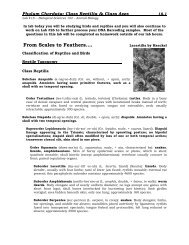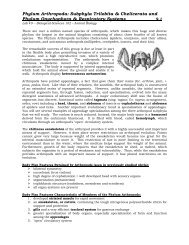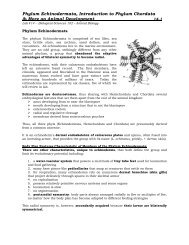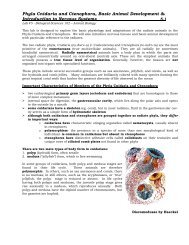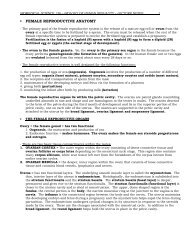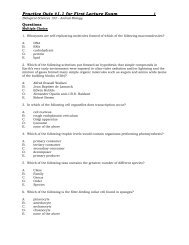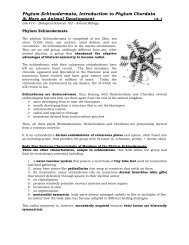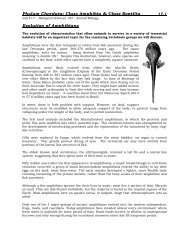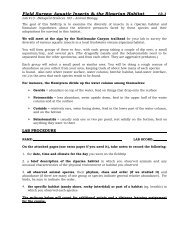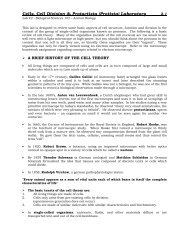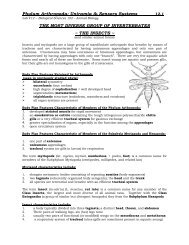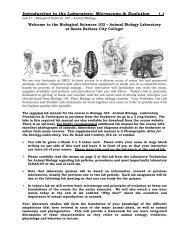Acoelomates: Phylum Platyhelminthes and Nemertea - Biosciweb.net
Acoelomates: Phylum Platyhelminthes and Nemertea - Biosciweb.net
Acoelomates: Phylum Platyhelminthes and Nemertea - Biosciweb.net
Create successful ePaper yourself
Turn your PDF publications into a flip-book with our unique Google optimized e-Paper software.
<strong>Acoelomates</strong>: <strong>Phylum</strong> <strong>Platyhelminthes</strong> <strong>and</strong> <strong>Nemertea</strong> <strong>and</strong><br />
Pseudocoelomates: Phyla Nematoda <strong>and</strong> Rotifera & Parasitism 6.2<br />
Lab #6 - Biological Sciences 102 – Animal Biology<br />
Classification & Adaptations of Acoelomate Animals<br />
<strong>Phylum</strong> <strong>Platyhelminthes</strong> (flatworms)<br />
Class Turbellaria (tur'bel-lar' e-a) (L. turbellae, stir, bustle, + aria, like or connected with).<br />
About 3000 species; Turbellarians. Mostly free-living, with a ciliated epidermis. A paraphyletic<br />
grouping. Example: Dugesia tigrina<br />
Class Monogenea (mon'o-gen'e-a) (Gr. mono, single, + gene, origin, birth). About 1100 species;<br />
Monoge<strong>net</strong>ic flukes. Adult body covered with syncytial tegument without cilia; leaflike to<br />
cylindrical in shape; posterior attachment organ with hooks, suckers, or clamps, usually in<br />
combination; all parasitic, mostly on skin or gills of fishes; single host; monoecious; usually<br />
free-swimming ciliated larva. Examples: Polystoma, Gyrodactylus<br />
Class Trematoda (trem'a-to'da) (Gr. trematodes, with holes, + eidos, form). About 10,000<br />
species; Dige<strong>net</strong>ic flukes. Adult body covered with nonciliated syncytial tegument; leaf-like or<br />
cylindrical in shape; usually with oral <strong>and</strong> ventral suckers, no hooks; development indirect,<br />
first host a mollusc, final host usually a vertebrate; parasitic in all classes of vertebrates.<br />
Examples: Fasciola, Clonorchis, Schistosoma<br />
Class Cestoda (ses-to'da) (Gr. kestos, girdle, + eidos, form). About 3500 species; Tapeworms.<br />
Adult body covered with non-ciliated, syncytial tegument; scolex with suckers or hooks,<br />
sometimes both, for attachment; long, ribbonlike body, usually divided into series of<br />
proglottids; no digestive organs; parasitic in digestive tract of all classes of vertebrates; first<br />
host may be invertebrate or vertebrate. Examples: Taenia, Diphyllobothrium<br />
<strong>Phylum</strong> <strong>Nemertea</strong> or Rhynchocoela (ribbonworms)<br />
About 600 species. Ribbon worms are often called nemertine or nemertean worms. Nearly all<br />
are marine <strong>and</strong> are characterized by an eversible proboscis that can be thrown out with great<br />
speed to capture food. Ribbon worms have separated the two functions of the gastrovascular<br />
cavity in flatworms <strong>and</strong> have a complete mouth-to-anus digestive tract <strong>and</strong> a circulatory<br />
system. <strong>Nemertea</strong>ns occur in the intertidal, under stones or sea weed, or in burrows in muddy<br />
s<strong>and</strong>. <strong>Nemertea</strong>ns can be very long at up to 50 meters (these species are the worlds<br />
longest animals).<br />
Body Plan Features & Characteristics of Members of the <strong>Phylum</strong> <strong>Nemertea</strong><br />
(some of these traits are seen in other animal phyla in addition to the <strong>Phylum</strong> <strong>Nemertea</strong>):<br />
1. acoelomate, bilateral symmetry, triploblastic structure<br />
2. some degree of cephalization = head with sensory organs<br />
3. some organ systems (formed of true tissues) are present<br />
4. eversible proboscis (only worm phylum with this characteristic)<br />
5. complete digestive tract/system (from mouth-to-anus)<br />
6. separate circulatory system with two lateral vessels on each side of the gut <strong>and</strong><br />
sinuses around head <strong>and</strong> tail; no definite closed circulation<br />
7. flame cells for excretion<br />
8. longitudinal <strong>and</strong> circular muscles contract against fibrous basement membrane;<br />
multiple patterns of muscle fiber organization<br />
9. hydrostatic skeleton (as muscles push against parenchyma <strong>and</strong> tissue fluids)<br />
10. dioecious with sexual reproduction or asexual fragmentation<br />
11. not parasitic, free-living



